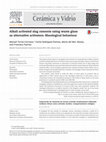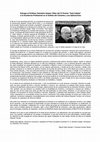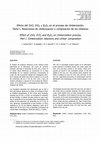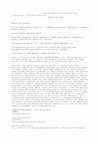Papers by Francisca Puertas
Materiales De Construccion, Mar 30, 1987
Modificaciones de las fases y de las resistencias mecánicas del clinker según el tipo de templado... more Modificaciones de las fases y de las resistencias mecánicas del clinker según el tipo de templado desde altas temperaturas Modifications clinl<er ptiase and mecanical strengtli in relation to type of quenctiing Fecha de recepción: 1/XII/86-Un aprovechamiento del contenido térmico del clínker caliente, del orden de 200 kcal/kg de clínker, que disminuye los costes de producción. 1.
La hidroxiapatita, Ca^(POJpH-(HAp), es una fase cristalina que tiene diversas aplicaciones en el ... more La hidroxiapatita, Ca^(POJpH-(HAp), es una fase cristalina que tiene diversas aplicaciones en el ámbito de determinados cementos especiales. Esa fase juega un importante papel en las reacciones de cementos utilizados en medicina para la reconstrucción defunciones del esqueleto. Se utiliza también para mejorar propiedades de materiales de aplicación odontológica. Por otra parte, se está estudiando para desarrollar conglomerantes cerámicos. En el presente trabajo se estudia la compatibilidad en estado sólido de la HAp conJS-CJSy C^S utilizando, a presión atmosférica y recinto abierto, composiciones enlazona rica en cal del sistema CaO-SiO^-Pp^ Lip dentro de los limites siguientes. CaO: 67-71 % ; SiO^: 318% ; PPy 9-29% (en peso). El tratamiento térmico se realizó en estado sólido y en atmósfera abierta. La
Summary A comparative study of the mineralogical composition of damagedartificial building materi... more Summary A comparative study of the mineralogical composition of damagedartificial building materials (mortars, plasters, etc.) andefflorescences taken from Toledo's cathedral has been carriedout by X-ray diffraction and IR spectroscopy. By means ofthe IR spectroscopy, several salts (Na 2 SO 4 , Na 2 SO 4 .10H 2 O,K 2 SO 4 ,3K 2 SO 4 .Na 2 SO 4 , CaSO 4 2H 2 O' CaSO 4 .K 2 SO 4 .H 2 O, KNO 3 , etc)have been identified. These compounds are present in verysmall amounts and, as a result, their identification by X-raydiffraction is difficult. The interpretation of these data reveals the existence ofseveral simultaneous mechanisms of degradation of the artificialbuildings materials. This is the case with some mortars containingsyngenite which has been produced by reaction of gypsum andK 2 SO 4 . This inolves the previous existence of gypsum as aproduct of degradation of CaCO 3 .

Materiales De Construccion, Aug 24, 2021
The use of industrial waste and/or by-products as alternative sources of raw materials in buildin... more The use of industrial waste and/or by-products as alternative sources of raw materials in building materials has become standard practice. The result, more sustainable construction, is contributing to the institution of a circular economy. Nonetheless, all necessary precautions must be taken to ensure that the inclusion and use of such materials entail no new health hazard for people or their environment. Due to the processes involved in generating industrial waste/by-products, these alternative or secondary materials may be contaminated with heavy metals, other undesirable chemicals or high levels of natural radioactivity that may constrain their use. In-depth and realistic research on such industrial waste is consequently requisite to its deployment in building materials.This paper reviews the basic concepts associated with radioactivity and natural radioactivity, focusing on industrial waste/by-products comprising Naturally Occurring Radioactive Materials (NORM) used in cement and concrete manufacture. Updated radiological data are furnished on such waste (including plant fly ash, iron and steel mill slag, bauxite and phosphogypsum waste) and on other materials such as limestone, gypsum and so on. The paper also presents recent findings on radionuclide activity concentrations in Portland cements and concretes not bearing NORMs. The role of natural aggregate in end concrete radiological behaviour is broached. The radiological behaviour of alternative non-portland cements and concretes, such as alkali-activated materials and geopolymers, is also addressed.
Data in Brief, Dec 1, 2020
Materiales De Construccion, Sep 30, 1995
Influencia de la incorporación conjunta del CaF^y del CaSO^ en el proceso de clinkerizacion. Obte... more Influencia de la incorporación conjunta del CaF^y del CaSO^ en el proceso de clinkerizacion. Obtención de nuevos cementos Influence ofthejoint incorporation ofCaF^and CaSO^ in the clinkerization process, Obíainment ofnew cements Fecha de recepdcn: 13-V-95

Boletin De La Sociedad Espanola De Ceramica Y Vidrio, Mar 1, 2015
The purpose of this study is to investigate news activators in the preparation of alkali-activate... more The purpose of this study is to investigate news activators in the preparation of alkali-activated materials (AAMs) alternative to Portland cements by reusing waste glass. Alkali-activated blast furnace slag (AAS) constitutes an alternative to Portland cement due to high energy and environmental pollution associated with industrial Portland cement. Moreover, alkali activated materials offer a series of higher properties than ordinary Portland cement (OPC), such as better strength and durability behaviour. However, the rheology of these materials has been much less intensely researched. The present study aimed to study the effect of waste glass as activator and as replacement of blast furnace slag on the rheological behaviour of AAS pastes, with a comparison between the rheological parameters and fluidity of these pastes to the same parameters in standard cements (CEM I and CEM III/B). The findings show that AAS paste behaviour of rheology when the activator was a commercial waterglass solution or NaOH/Na 2 CO 3 with waste glass was similar, fit the Herschel-Bulkley model. The formation of primary C-S-H gel in both cases were confirmed. However, the rheological behaviour in standard cements fit the Bingham model. The use of the waste glass may be feasible from a rheological point of view in pastes can be used.
Cement and Concrete Research, Mar 1, 1997
The kinetics of hydration of alkali-activated slag (AAS) have been studied for different temperat... more The kinetics of hydration of alkali-activated slag (AAS) have been studied for different temperatures. The alkaline activator used was a mix of water-glass and NaOH solution. The degree of reaction was determined by means of the heat of hydration after the induction period. The reaction mechanism determined for AAS pastes was a diffusion mechanism and their activation energy was 57.6 KJ/mol.

MATEC web of conferences, 2018
A clear alternative to reach the goal of sustainable development in the Construction Sector is th... more A clear alternative to reach the goal of sustainable development in the Construction Sector is the development of alternative building materials to Ordinary Portland Cement (OPC) in a more energetically as well as environmentally eco-efficient way. Alkaline cements (Alkali-Activated Materials, AAMs) and geopolymers meet these requirements; and they are based on the alkali activation of aluminosilicates (mainly waste and industrial by-products, such as blast furnace slag, fly ash and ceramic waste) in highly alkaline solutions. AAMs cements and concretes are notable for being very durable and mechanically resistant. However, to date their rheological behaviour is not well controlled and there is little understanding of it, with very disparate experimental data. Despite this, their rheological behaviour is not fully understood and little is known on the disparate data obtained in AAM pastes. Moreover, the common additives used in the preparation of OPC concretes and the rheology modifiers/controllers are also unstable in the AAMs systems. Understanding and controlling the rheology of the AAMs systems will ultimately determine whether they can be implemented in the market, and will open up greater competitive possibilities in a crisis-affected sector. A systematic study of the factors that affect the rheological properties of AAMs (pastes, mortars and concretes) is therefore necessary in order to ultimately develop more resistant and durable materials.
DOAJ (DOAJ: Directory of Open Access Journals), Sep 1, 2011
Materiales De Construccion, Sep 30, 1995
Se presenta el estado del conocimiento actual de los cementos y hormigones de escorias activadas ... more Se presenta el estado del conocimiento actual de los cementos y hormigones de escorias activadas alcalinamente, detallándose las características y propiedades de los citados materiales. Se incide especialmente en aquellos aspectos de carácter científico y técnico que permanecen sin resolver y que, por tanto, precisan nuevas investigaciones. The paper presents the state ofthe art in cements and concretes with alkaline-activated slag. Characteristics and properties ofthese materials are given. Special emphasis is made on those scientific and technical aspects which remain unsolved and which, therefore, cali for further research.

Advances in Cement Research, Jul 1, 2003
This paper examines on the setting time and mechanical strength behaviour of slag cement pastes a... more This paper examines on the setting time and mechanical strength behaviour of slag cement pastes activated with different alkaline activators. For this purpose three alkaline solutions were used: waterglass solution (27% SiO2, 18 % Na2O and 55% H2O), NaOH and Na2CO3, maintaining always a constant concentration of Na2O (4% by mass of slag). The solutions were prepared with mixes of 0%, 80%/20% and 20%/80%. The activation process was studied at early ages by conduction calorimetric and fourier transform infrared spectroscopy (FTIR). Results show that the initial pH of the alkaline solution plays an important role in the initial slag dissolution. However the factor playing a decisive role in the acceleration or delay of setting times and in the development of mechanical strengths is the nature of the anion present in the solution. [Formula: see text] ions act as an accelerator of the setting time, but [Formula: see text] ions delay the setting time.

Materiales De Construccion, Dec 30, 2011
2011, se entregó al profesor Demetrio Gaspar Tébar el II Premio "José Calleja" a la Excelencia Pr... more 2011, se entregó al profesor Demetrio Gaspar Tébar el II Premio "José Calleja" a la Excelencia Profesional en el ámbito del Cemento y sus Aplicaciones. La entrega del Premio la llevó a cabo del director del IETcc, D. Víctor Velasco, el director general de OFICEMEN, D. Aniceto Zaragoza, el director general de IECA, D. Juan Carlos López Agüí, y el vicepresidente adjunto del CSIC de Áreas Científico-Técnicas, D. Juan José Damborenea. El acto fue muy emotivo y entrañable. El profesor Dr. D. Demetrio Gaspar Tebar agradeció el premio y, en un discurso muy emotivo (que insistió en pronunciarlo de pie), recordó a todas aquellas personas que, de una u otra manera, habían estado con él durante su trayectoria profesional y personal, y que le habían apoyado a lo largo de su vida. El Consejo de Redacción de la revista Materiales de Construcción considera totalmente merecido este reconocimiento al trabajo del profesor Dr. D. Demetrio Gaspar en el campo de la química del cemento, y, desde estas páginas, queremos expresar nuestro agradecimiento a las instituciones (CSIC, OFICEMEN e IECA) que se lo han otorgado. Demetrio ha tenido siempre una vinculación muy estrecha con la revista, siendo miembro de diferentes Consejos de Redacción y del actual Consejo Asesor.

Materiales De Construccion, Dec 2, 2008
El empleo de residuos cerámicos como materia prima alternativa en la fabricación del crudo de cem... more El empleo de residuos cerámicos como materia prima alternativa en la fabricación del crudo de cemento Portland, aumenta el contenido de ZnO, ZrO 2 y B 2 O 3 en el clinker. Estos elementos se encuentran en la capa esmaltada de los residuos cerámicos incorporados al crudo. Por ello el presente trabajo de investigación aborda el estudio del efecto que tiene la adición en el crudo de contenidos del 0,5 y 2% de ZnO, ZrO 2 y B 2 O 3 de manera individual y conjunta en los procesos de clinkerización, en la distribución y morfología de las fases mineralógicas del clinker. Los resultados obtenidos han demostrado que el ZnO y ZrO 2 permanecen fijados en el clinker, sin embargo el B 2 O 3 se volatiliza parcialmente. El ZnO actúa como fundente, mientras que el ZrO 2 y el B 2 O 3 no aumentan el contenido de fase fundida. La adición de estos óxidos al crudo modifica el contenido de las principales fases mineralógicas del clinker. El ZnO disminuye los contenidos de C 3 S y C 3 A, el ZrO 2 disminuye marcadamente la fase ferrítica y el B 2 O 3 estabiliza el C 2 S. En los clinkeres obtenidos a partir de la adición del 2% de ZnO y ZrO 2 se identifica la presencia de nuevas fases mineralógicas, 3CaO•ZnO•2Al 2 O 3 , y CaZrO 3 .

Construction and Building Materials, Nov 1, 2019
The use of admixtures in mortars to improve both their physical-chemical and ornamental features ... more The use of admixtures in mortars to improve both their physical-chemical and ornamental features has become increasingly common in recent years. The varying origin and composition of these products, some sourced from waste produced in other industries, poses the question of whether they modify the activity concentration index (ACI) of the construction materials to which they are added. Seven pigments, some of natural and others of artificial origin, and two water repellents were characterised both chemically and radiologically in this study. Neither the synthetic pigments nor the water repellents exhibited significant radiological content. The pigments based on Fe2O3 of natural origin had detectable activity concentrations of naturally occurring radionuclides from the 238U series. Those levels were attributable to the raw material used, namely the bauxite red mud generated in aluminium production. In addition to Si, Al, Fe, Ca, Ti and Na as majority elements, this sludge also contains traces of K,

MATEC web of conferences, 2014
The development of alternatives to traditional Portland cement produced with more eco-efficient p... more The development of alternatives to traditional Portland cement produced with more eco-efficient processes (lower energy consumption and CO 2 gas emissions) is an item on climate change and innovation agendas. Alkaline cements and concretes are an effective alternative to traditional cements. The structure of the C-S-H gel in Portland cements consists mostly of 14-nm tobermorite (with a chain length of five) and jennite (2-link chain). The mechanical properties of C-S-H gels can be explained in terms of the three types of packing found in these gels: low density (LD), high density (HD) and ultra-high density (UHD). The main reaction product in alkali-activated slag (AAS) cements is a C-AS -H gel, which adopts different structures depending on the nature of the alkaline activator. When the activator is a NaOH solution (4 % Na 2 O by slag weight), the C-AS -H gel formed has an intermediate structure between 14-nm tobermorite with a chain length of five links and 11-nm tobermorite with 14 links. When the activator is a waterglass solution (4 % Na 2 O by slag weight), traits characteristic of 14-nm tobermorite with 11-link chains and 11-nm tobermorite with a chain length of 14 co-exist in the structure of the C-AS -H gel formed. This densely packed structure (with three HD states) yields excellent mechanical properties. Like the C-AS -H gels obtained in NaOH (4% Na2O)-activated AAS paste, the C-AS -H gels forming in AAS gels activated with waterglass have no UHD states. The structure and composition of these C-AS -H gels determine strength development in AAS mortars and concretes as well as their resistance to aggressive chemicals.

Materiales De Construccion, Mar 30, 2001
El objetivo del presente trabajo fue evaluar la validez de diferentes métodos, no calorimétricos,... more El objetivo del presente trabajo fue evaluar la validez de diferentes métodos, no calorimétricos, utilizados en la determinación del grado de reacción de pastas de escoria activada alcalinamente. Los métodos utilizados fueron: (a) método de separación química por disolución en metanol ácido-salicilico; (b) determinación de las pérdidas de masa entre 100-600 °C en las curvas de TG, pérdidas asociadas a la cantidad de agua químicamente combinada: (c) cuantificación de la señal de-74 ppm de los espectros de ^^Si RMN MAS. Las variables consideradas en el proceso fueron: naturaleza del activador alcalino (Waterglass, Na^CO^ y NaOH), concentración del activador (4% y 3% de Nafi en masa respecto a la escoria), temperatura de curado (25 y 45 °C), superficie específica de la escoria (460 y 900 m^/kg) y tiempo de reacción (de 7 días a 18 meses). Los resultados obtenidos indican que ninguno de los tres métodos es definitivo pero sí son complementarios y permiten seguir la evolución reactiva de la escoria activada alcalinamente. El método basado en la cuantificación de la señal de-74 ppm de los espectros de ^^Si RMN MAS es el más adecuado. The aim of the present work was to evaluate the validity of non-calorimetric different methods, used in the determination of reaction degree of alkaline activated slag pastes. The methods used were: (a) chemical separation by methanol-salicylic acid; (b) determination of the weight loss mass between 100-600 °C in TG curves, associated to chemically combined water; (c) quantification of the-74 ppm signal in ^^Si MAS-NMR spectra. The parameters considered in the process were: nature of the alkaline activator (Waterglass, NaJZO^ and NaOH), activator concentration (4% and 3% Nafi in mass with respect to the slag), curing temperature (25 and 45 °C), slag specific surface (460 and 900 m^/kg) and time of reaction (from 7 days to 18 months). The results obtained indicate that none of the three methods is definitive but complementary and they provide to follow the reactive evolution of the alkaline activated slag cements. The method based on the quantification of the-74 ppm signal in the ^^Si MAS NMR is the most suitable method. 1. INTRODUCCIÓN La bibliografía existente no recoge ningún método físico-químico válido que permita determinar el grado de reacción en pastas de escorias activadas alcalinamente (AAS). Diversos autores (1, 2, 3,4) L INTRODUCTION The bibliography does not collect any physicochemical method to determine the reaction degree in pastes of alkaline activated slag (AAS). Some authors (J, 2, 3, 4) define the hydration degree as a function








Uploads
Papers by Francisca Puertas